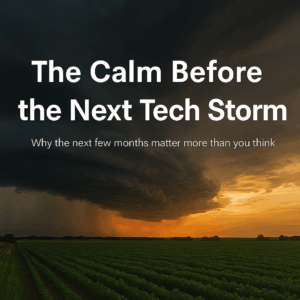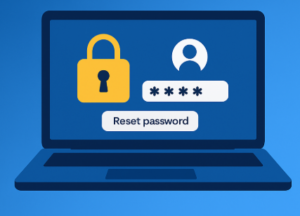The Calm Before the Next Tech Storm
(Why the next few months matter more than you think)
If you’ve been anywhere near the tech world lately, you’ve probably noticed things feel… jumpy. It’s like everyone’s waiting for something big to break loose again — maybe AI, maybe cybersecurity, maybe another round of “help, my email got hacked.”
Every few years we hit one of these inflection points — moments where the tools we use start changing faster than our ability to keep them secure. And like clockwork, that’s where we are again heading into 2026.
For most small and mid-sized businesses, this is the part where excitement and anxiety start fighting for the front seat. The promise of smarter automation, cheaper computing, and better tools is right there — but so is the risk that one bad click or misconfigured policy can cost you everything.
That’s where a good MSSP (Managed Security Service Provider) earns its paycheck: helping you move forward without walking into an ambush.
1. AI: The Gift and the Gremlin
Artificial intelligence is the new electricity — it’s everywhere, whether you asked for it or not. Every vendor suddenly has an “AI-powered” version of their product, and every hacker suddenly has a smarter toolkit.
That’s the part most people miss: AI isn’t just making businesses faster. It’s also making bad guys faster.
We’ve seen phishing emails that look like they were written by your office manager, fake invoices that pass every grammar test, and voice scams that sound like your CFO asking for a wire transfer. The line between “clever” and “criminally convincing” has blurred.
The takeaway: if you think your staff can “spot the fake ones,” they can’t anymore — at least not without help. This is where behavior-based security tools and continuous monitoring become essential. You can’t outthink AI scams, but you can out-prepare them.
2. The Cloud Isn’t Magic. It’s Just Someone Else’s Computer.
Remember when the cloud was supposed to solve everything? Yeah, about that.
Turns out, moving your stuff to the cloud doesn’t automatically make it safe — it just changes what kind of trouble you can get into. We’ve seen data backups left exposed, security tokens that never expire, and user accounts that survived three IT managers.
The most common problem? Configuration drift. Someone set it up right once, and everyone assumes it’s still right. Spoiler: it’s not.
The solution is boring but vital — regular security reviews. You’d be shocked how many “breaches” are really just neglected settings from two years ago.
3. Cyber Insurance: Now With Homework
Cyber insurance used to be like a seatbelt — you just clicked it and moved on. Not anymore.
Now, insurers want proof you’re not driving blindfolded. They’re asking about MFA, endpoint monitoring, and documented response plans. If your answers are fuzzy, your premiums won’t be.
We’ve started walking clients through pre-insurance audits — cleaning up weak spots before underwriters find them. It’s not glamorous, but it’s the difference between “we’re covered” and “we thought we were covered.”
And honestly, this trend isn’t bad. It’s forcing accountability — and that’s something IT needed.
4. The Real Shortage Isn’t Hardware. It’s Humans.
There’s no shortage of firewalls, EDR agents, or AI tools. What’s missing are people who can make sense of them.
You don’t just need someone who can configure a policy — you need someone who can explain what that policy means for your business, your customers, and your risk profile. That bridge between security and strategy is where most companies stumble.
A good MSSP doesn’t drown you in alerts. They translate the noise into decisions. That’s the difference between “outsourced IT” and a real security partner.
5. Compliance Isn’t Just Paperwork Anymore
SOC 2, FTC Safeguards, HIPAA, PCI… the alphabet soup never ends. But compliance is quietly becoming a competitive edge.
These days, new clients don’t just ask, “Are you secure?” They ask for proof. They want reports, policies, screenshots — the receipts. If you can hand them over without breaking a sweat, that’s trust you can’t buy with advertising.
We’ve seen it firsthand: companies landing new contracts simply because they could show their security posture instead of promising it.
6. Endpoints: The Wild West Returns
Here’s the reality: your employees are working from everywhere. Their homes, coffee shops, airports — sometimes all in one day. They’re on personal phones, laptops, tablets, even the occasional “it’s just for one email” family computer.
That’s a security nightmare waiting to happen.
The fix isn’t locking everything down — that just leads to shadow IT and resentment. The fix is visibility. Tools like Intune and Defender let you see what’s connecting, from where, and whether it’s behaving.
You don’t have to control everything. You just have to see it before it bites you.
7. Things You Should Probably Do Before December
If you’re not sure where to start, here’s the short list:
- Disable any user accounts that aren’t active.
- Double-check MFA for every login — especially admins and vendors.
- Review your backup plan and test it.
- Make sure your response plan is written down somewhere that isn’t in someone’s inbox.
- Schedule a full security posture review before the holidays.
Think of it as a year-end oil change for your network. Skip it, and you’ll pay for it later.
8. What 2026 Will Probably Look Like
2026 is shaping up to be loud.
AI tools will get smarter, scams will get weirder, and regulations will finally start growing teeth. Expect fines for data sloppiness, not warnings. Expect insurers to drop “high-risk” clients faster. Expect the conversation around security to shift from “IT problem” to “business survival strategy.”
But here’s the upside: security tools have never been more capable or affordable. You can have real-time threat detection, automated response, and detailed reporting for less than you probably spent on your copier contract five years ago.
That’s the silver lining — small and mid-sized businesses can finally fight on equal footing.
The Bottom Line
Technology is moving fast enough that even cautious companies get dragged along. That’s okay — evolution’s messy. The goal isn’t to stay ahead of everything; it’s to make sure you’re not the easiest target.
At Vision Quest Information Solutions, we’ve spent years helping clients walk that line — secure enough to sleep at night, flexible enough to get work done.
So whether you’re already with an MSSP or thinking about finally getting one, ask yourself a simple question: When’s the last time someone really looked under the hood?
If the answer is “a while,” let’s fix that before the next storm hits.









